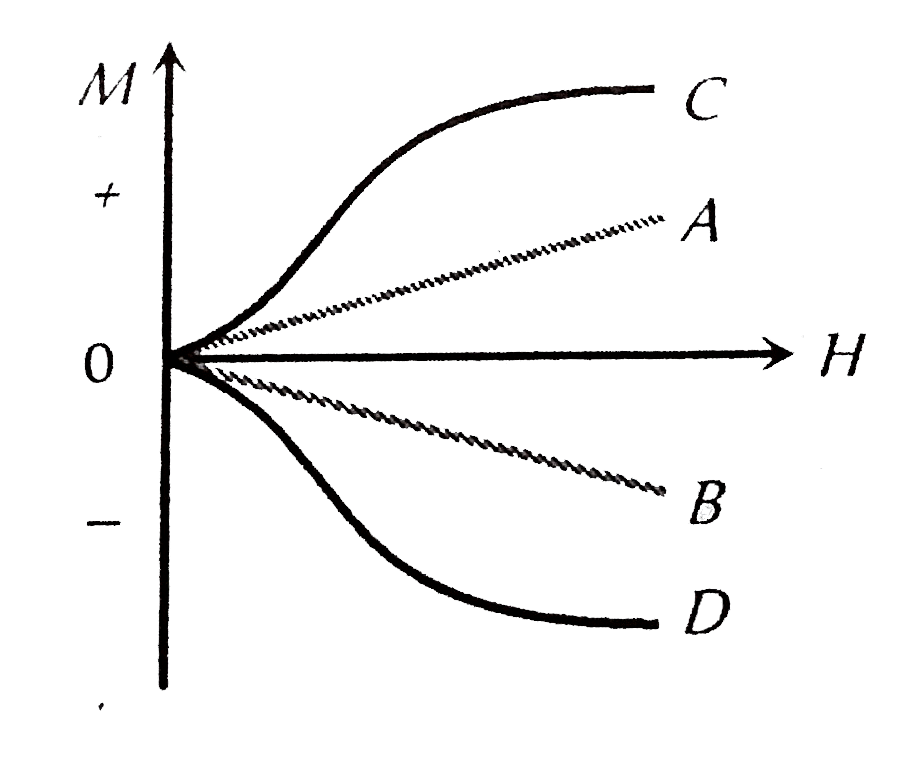Why does a paramagnetic substance display greater magnetisation for the same magnetising field when cooled ? How does a diamagnetic substance respond to similar temperature changes ?
Although each individual atom of a paramagnetic material has a definite dipole moment, the ceaseless random thermal motion of the atoms oppose their orientation in the direction of magnetising field. However, when cooled, the thermal motion of the atoms is reduced and consequently atoms of a paramagnetic material have a greater tendency to align themselves in the direction of external magnetising field. As a result the paramagnetic substance shows greater magnetisation at low temperatures.
As atoms of a diamagnetic substance do not have any permanent dipole moment, there is practically no effect of change in temperature on magnetisation of a diamagnetic substance.
Topper's Solved these Questions
- BOOK - U-LIKE SERIESCHAPTER - MAGNETISM AND MATTEREXERCISE - LONG ANSWER QUESTIONS-I20videos
MAGNETISM AND MATTER
- BOOK - U-LIKE SERIESCHAPTER - MAGNETISM AND MATTEREXERCISE - LONG ANSWER QUESTIONS-II2videos
MAGNETISM AND MATTER
- BOOK - U-LIKE SERIESCHAPTER - MAGNETISM AND MATTEREXERCISE - VERY SHORT ANSWER QUESTIONS28videos
MAGNETISM AND MATTER
- BOOK - U-LIKE SERIESCHAPTER - EXAMINATION PAPER 2020 (SOLVED)EXERCISE - SECTION D6videos
EXAMINATION PAPER 2020 (SOLVED)
- BOOK - U-LIKE SERIESCHAPTER - MODEL TEST PAPER 1 (UNSOLVED)EXERCISE - SECTION B1videos
MODEL TEST PAPER 1 (UNSOLVED)
Similar Questions
Why does a paramagnetic sample display greater magnetisation (for the same magnetising field) when cooled ?
View SolutionA: Paramagnetic sample displays greater magnetisation (for the magnetizing field) when cooled.
R: The tendency to disrupt the alignment of dipoles (with the magnetising field) arising from random thermal motion is reduced at lower temperatures.View Solution
Knowledge Check
- Question 1 - Select One
Assertion: A paramagnetic sample display greater magnetisation (for the same magnetising field) when cooled.
Reason: The magnetisation does not depend on temperature.AIf both the assertion and reason are true and reason is a true explanation of the assertion.BIf both the assertion and reason are true but the reason is not the correct explanation of assertion.CIf the assertion is true is true but reason is false.DIf both the assertion and reason are false. - Question 2 - Select One
Assertion: A paramagnetic sample display greater magnetisation (for the same magnetising field) when cooled.
Reason: The magnetisation does not depend on temperature.AIf both assertion and reason are true and reason is the correct explanation of assertion.BIf both assertion and reason are true but reason is not the correct explanation of assertion.CIf assertion is true but reason is false.DIf assertion and reason both are false. - Question 3 - Select One
The most appropriate magnetization M versus magnetising field H curve for a paramagnetic substance is
 AABBCCDD
AABBCCDD
Why does the magnetisation of a paramagnetic salt increase on cooling?
View SolutionAs per Curie's law the magnetisation of a paramagnetic substance is inversely proportional to the absolute temperature but magnetisation of a diamagnetic substance is directly proportional to the absolute temperature.
View SolutionAssertion (A) : A paramagnetic sample displays greater manetisation, for the same magnetising field, when cooled.
Reason (R) : At lower temperature the individual atomic dipoles of a paramagnetic material can be easily aligned in the direction of the magnetising field.View SolutionA: Paramagnetic sample displays greater magnetisation (for the magnetizing field) when cooled.
R: The tendency to disrupt the alignment of dipoles (with the magnetising field) arising from random thermal motion is reduced at lower temperatures.View SolutionThe variation of magnetic susceptibility (χ) with magnetising field for a paramagnetic substance is
View Solution

